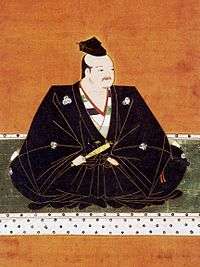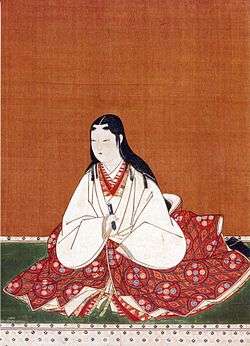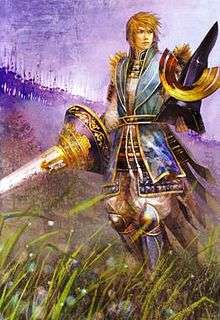Azai Nagamasa
Azai Nagamasa (浅井 長政, 1545 – September 26, 1573) was a daimyō during the Sengoku period of Japan. His clan, the Azai clan, were located in northern Ōmi Province, east of Lake Biwa. He was the husband of Oichi and brother-in-law of Oda Nobunaga, starting in 1564, and one of Nobunaga's enemies from 1570 to 1573. Nagamasa and his clan were destroyed by Oda Nobunaga in August 1573. Major battles of Azai Nagamasa include the battle of Anegawa in 1570 and the many sieges of Odani castle between 1570 and 1573.

Early life and marriage
Azai Nagamasa was the son of Azai Hisamasa, from whom he inherited clan leadership in 1560. Hisamasa had been compelled to step down by many of his retainers in favor of his son, Nagamasa. Hisamasa retired, and would later commit suicide along with his son in August 1573. Nagamasa successfully battled both Rokkaku Yoshikata and Saitō Tatsuoki between 1560 and 1564. He is remembered as being a capable commander of troops on the battlefield.

He married Oda Nobunaga's sister Oichi in 1564. Nobunaga desired peaceful relations with the Azai clan because of their strategic position in between Oda clan land's and the capital, Kyoto.[1][2]
Clan conflict
In 1570, Oda Nobunaga declared war on the Asakura family of Echizen. The Asakura and Azai had been allies since the time of Nagamasa's grandfather. This sudden war between two Azai clan allies is reported to have divided the clan. Many retainers wished to honor the alliance with the Asakura, while Nagamasa himself is reported to have favoured staying neutral, essentially siding with Nobunaga. In the end, the Azai clan chose to honor the generations-old alliance with the Asakura and came to their aid. Initially, this decision caused Nobunaga's army, which was marching upon the Asakura's lands, to retreat back to Kyoto. However, within a few months the forces of Nobunaga were again on the march, but this time they marched on Azai lands.[2]:60–61
In the summer of 1570, Oda Nobunaga and Tokugawa Ieyasu brought an army estimated between 20-30,000 men into Northern Omi. The Azai called upon their allies, the Asakura, for assistance. The Asakura responded by sending troops. In either June or July, the two sides met at the battle of Anegawa. The combined Azai and Asakura force numbered between 15-20,000 men. The outcome is recorded elsewhere, but briefly: The battle was strongly contested by both sides. Nobunaga is recorded as having decided that his force should directly confront the numerically inferior Azai clan force, while Ieyasu would engage the Asakura. While the Oda were being held at bay, and perhaps even slowly losing ground to the Azai - who had fought against numerically superior forces in the past - Ieyasu's force was apparently quickly gaining the advantage against the Asakura. Ieyasu, or perhaps one of his battle commanders, decided to send part of the Tokugawa force into the Azai flank, forcing the Azai to retreat, and guaranteeing victory. However, the battle was strategically indecisive because the Oda shortly withdrew.
Over the course of the next two years, with the exception of occasional interventions by the Shogun, Azai Nagamasa was under constant threat of Nobunaga aggression into Omi. Often these threats manifested into sieges of the Azai capital of Odani. During this period the Azai are seen as being loosely aligned with numerous anti-Oda forces, including the Asakura, the Miyoshi, the Rokkaku, and several religious complexes.
Siege of Odani and death
In 1573, Oda laid siege to Odani Castle. Although the Asakura sent a relief force, Nobunaga defeated this force and chased the Asakura into their lands. Shortly thereafter, the Asakura were destroyed. Nobunaga then returned south to prosecute the Siege of Odani Castle.
Nagamasa had no hope of winning, and chose to commit seppuku. Before dying, he entrusted his wife Oichi and their three daughters to Nobunaga.[2]:65[3]
Nobunaga later convinced Oichi to tell him where she had sent her infant son and Nagamasa's male heir, Manpukumaru, saying that he wanted the boy to live with and raise him. However, Nobunaga had Hideyoshi execute Manpukumaru, and the head was displayed on a stake. Nobunaga ensured that his sister, Oichi, was uninformed of this but she eventually came to that suspicion. There are reports that Nobunaga bore a strong grudge against Nagamasa for his perceived betrayal of their alliance even though it was he who broke the agreement first. It has also been reported that Nobunaga had the skulls of Nagamasa, Hisamasa, and the Asakura leader lacquered so that they could be used as cups, but whether this is historically accurate or merely fabricated to heighten Nobunaga's reputation is debatable.
Family
- Father: Azai Hisamasa (1526–1573)
- Mother: Ono-dono (1527-1573)
- Wives:
- daughter of Hirai Sadatake
- Oichi
- Concubine: Yae no Kata
- Sisters:
- Akuhime (1538–1585)
- Ōmi no Kata
- Kyōgoku Maria (1543–1618)
- Wife: Oichi (1547–1583)
- Children:
- Chacha, or Yodo-dono (1569–1615), also known as Daiko'in, concubine of Toyotomi Hideyoshi and mother of Hideyoshi's heir Hideyori
- Hatsu (1570–1633), wife of the sengoku daimyō Kyōgoku Takatsugu
- Oeyo (1573–1626), or Sūgen'in, wife of the second Tokugawa shogun Hidetada and mother of his successor and elder son Iemitsu.
- Manpukumaru (c. 1563 – 1573)
- Manjumaru
- Shichiro later Azai Nagaakira, born by Yae no Kata
- Enjumaru later Azai Seiji
- Kusu no Tsubone later Hokoin, Toyotomi Hideyoshi's concubine
- Gyobukyo no Tsubone (1570-1661), Senhime's nanny
In popular culture

- Azai Nagamasa is one of the main characters in recent action/RPG PS4 exclusive game Nioh 2, with a whole region being based about him and his battles against Oda Nobunaga.
- Nagamasa makes appearances as a general in the Main Campaign and in various Historical Battles and Historical Campaigns in the PC game Shogun: Total War. Additionally, Nagamasa returns as an Heir to the Azai Clan in the fan created Samurai Warlords Mod (aka the Shogun Mod) for the PC game Medieval Total War.
- Nagamasa is a playable character in the video game series Samurai Warriors, where he is depicted as an extremely honourable man who will stop at nothing to enforce his notions of justice are. As in real life, Nagamasa is allied with the Asakura against Nobunaga at Anegawa; his expression of love for Oichi is however more dramatised, showing him as caring deeply for her welfare. He is depicted with his traditional kabuto helmet and uses a lance as his weapon. This version of Nagamasa also appears in the spin-off series Warriors Orochi as an unlockable character for the Cao Wei storyline.
- Nagamasa is an NPC in Sengoku Basara 2, along with Oichi, but becomes playable in the expansion Sengoku Basara 2: Heroes. He wields a long sword and carries a shield with him and is portrayed as a justice loving man, whose words and actions invokes a lot of the tokusatsu genre. He returns as a playable character in Sengoku Basara 4.
- Nagamasa serves as the basis for the protagonist character in the video game Pokémon Conquest.
References
- Sansom, George (1961). A History of Japan, 1334–1615. Stanford University Press. pp. 277–278. ISBN 0804705259.
- Turnbull, Stephen (1987). Battles of the Samurai. Arms and Armour Press. p. 59. ISBN 0853688265.
- Turnbull, Stephen (2000). The Samurai Sourcebook. London: Cassell & C0. p. 224. ISBN 1854095234.
- "The Samurai Archives Japanese History Page". Samurai-archives.com. Retrieved 30 June 2018.
- "Asai Nagamasa". Wiki.samurai-archives.com. Retrieved 30 June 2018.
- This article incorporates text from OpenHistory.